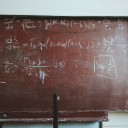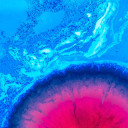Fermion-boson systems in and out of equilibrium
As a common approach to theoretical spectroscopy, the bosonic degrees of freedom can be approximated by effective interactions or dissipation. In the last decades, however, many experiments revealed interesting phenomena that need a more elaborate description, where bosons and fermions are treated on the same quantized footing [1].
Incorporating photonic and phononic degrees of freedom ab initio in fermionic systems is a possible but formidable task to be tackled over the next decade. Established methods such as DFT, master equations, MPBT, and strong coupling approaches such as DMFT are getting extended by quantum electrodynamical DFT methods [2] or generalized Kadanoff-Baym approaches [3].
Chemical landscapes of complex molecules that are modified by cavities [4], for instance, have to be described by coupled fermion-boson models. Driven coupled systems even form entirely new states of matter, which lead to extraordinary exciton conductance in organic materials [5], light-induced superconductivity in cuprates [6], or phonon-mediated electron transport [7]. The theoretical description of such phenomena is the main focus of this session.
References:
[1] F. Giustino, Rev. Mod. Phys. 89(1), 015003 (2017).
[2] M. Ruggenthaler, J. Flick, C. Pellegrini, H. Appel, I. V. Tokatly, and A. Rubio, Phys. Rev. A. 90(1), 012508 (2014).
[3] P. M. M. C. de Melo, and A. Marini, Phys. Rev. B 93, 155102 (2016).
[4] T. Schwartz, J. A. Hutchison, C. Genet, and T. W. Ebbesen, Phys. Rev. Lett., 106(19), 196405 (2011).
[5] J. Feist, and F. J. Garcia-Vidal, Phys. Rev. Lett. 114(19), 196402 (2015).
[6] D. Fausti, R. I. Tobey, N. Dean, S. Kaiser, A. Dienst, M. C. Hoffmann, S. Pyon, T. Takayama, H. Takagi, A. Cavalleri, Science 331, 189 (2011).
[7] Y. Cui, S. Tosoni, W.-D. Schneider, G. Pacchioni, N. Nilius, and H.-J. Freund, Phys. Rev. Lett. 114, 016804 (2015).
Invited Speaker:
Denis Golež Post-Doc, University of Fribourg, Fribourg
In 2014, Denis Golež holds a PhD from the University of Ljubljana, Slovenia. His PhD was attributed for his work on “Dynamics of the polaron systems out of the equilibrium” under the supervision of J. Bonča. He continued with a postdoctoral position at the University of Fribourg, Switzerland in the group of P. Werner. Her successful scientific work manifests in 14 peer-reviewed articles.







